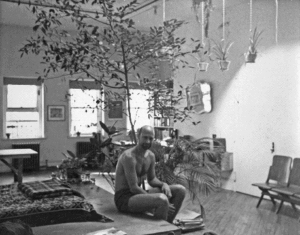 Douglas Crimp is an important figure in the development of postmodern art theory. He influenced a group of such 1970s artists as Robert Longo, Philip Smith and Cindy Sherman, whom he dubbed the “Pictures Generation.”
Douglas Crimp is an important figure in the development of postmodern art theory. He influenced a group of such 1970s artists as Robert Longo, Philip Smith and Cindy Sherman, whom he dubbed the “Pictures Generation.”
Crimp made his mark curating a small show in 1977, titled “Pictures” at New York’s Artists Space gallery that has gained iconic status as a seminal moment in postmodern art history. His reputation was cemented by his thirteen-year association with October, the influential art journal that championed postmodern art and French post-structural theory. Readers coming to “Before Pictures” hoping to delve deeper into Crimp’s pre-Pictures art life and ideas will be disappointed. The book, instead, chronicles his first ten years in the city (1967-77), giving only a cursory glimpse of its explosive art scene alongside his wider adventures as a promiscuous gay man during that pre-AIDS era.
Crimp appears to have led a charmed life during that decade. His tale is one of relatively little struggle as he navigates his way in the city’s highly competitive art world. At 18, he wins a scholarship to study art history at New Orleans’ Tulane University. No reference is made to what he learned in class. Instead, he reveals that he visited his first gay bar and had his first post-puberty sexual experience while at Tulane.
When he moves to New York, he shares an apartment with two college friends. He quickly falls in with an artistic circle who help him, through the years, land a series of apartments, starting in Spanish Harlem then moving down-town over the years to Chelsea, Greenwich Village and Tribeca. Next, he lands a job at the Guggenheim Museum because he visits the museum the day the director has just fired the guest curator of a Peruvian art show. Crimp talks his way into installing the exhibit and becoming a curator. He starts writing reviews at ArtNews in 1972 because the magazine’s managing editor is a friend of Diane Waldman, his curatorial friend at the Guggenheim. Finally, he enrolls at City University of New York’s Graduate Center in 1976 to study contemporary art theory with October’s founder, Rosalind Krauss. Within a year, he is appointed the journal’s managing editor.
All in all, this contemporary Candide was living in the best of all possible worlds. This is not to deny that Crimp clearly possessed formidable intellectual and writing chops to power his uninterrupted success but must also attribute some of his good fortune to his fortuitous friendships. Crimp’s writing style is fluid and holds one’s attention. As someone who also lived in the city at that time, I found his evocation of a dynamic and grittier New York during the 1970s appealing, though I longed for more recollections about artist hangouts and the gallery scene.
He mentions Fanelli’s Café on Prince Street in passing but a more constant hangout was the late Max’s Kansas City bar. Rather than stay in the front room where the art crowd gathered, he preferred the back room with Andy Warhol’s Factory crowd and other gay patrons. A Dan Flavin sculpture that hung above a booth in the corner dominated the room.
The chapter titled Disssco (A Fragment) is the book’s best chapter. It brings the underground scene of private, late-night gay bars in commercial buildings and lofts to life. This is where Crimp spent endless ecstatic nights dancing till dawn while occasionally high on drugs. As a highly handsome gay man, he revels in recounting his active sexual escapades, picking up tricks in bars and also engaging in anonymous sex behind delivery trucks on the far Westside.

The book’s art design deserves mention. A particularly fine touch has each chapter open- ing with a photo of the five dwellings Crimp lived in his first decade in the city: Spanish Harlem (1967-69), Chelsea (1969-71), Greenwich Village (1971-74), Tribeca (1974-76) and the Financial District (Since 1977).
“Before Pictures” tale combines autobiography with some cultural history. The narrative skews more toward his adventures as a gay blade. I found Crimp’s tell-all account of his gay youth off-putting at first but came to see that art and sex were inseparable strands of his identity.
In that respect, Crimp can serve as an avatar of that era, a time when our ideas about art and attitudes toward sexuality were in highly transitional flux.
“Before Pictures” is a co-publication of the University of Chicago and Dancing Foxes Press, 2016.
Tom Mullaney, has written on Art for The New York Times, Crain’s and Chicago Magazine. His arts blog is at www.ArtsandAbout.com.
Volume 31 no 4 March / April 217 pp 35 – 36
